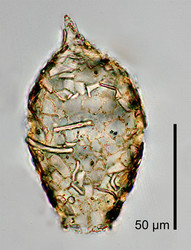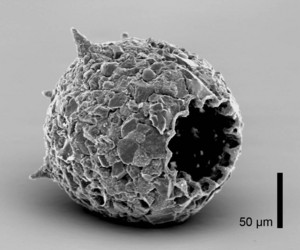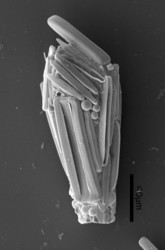Difflugia
Ralf Meisterfeld and Edward MitchellIntroduction
Difflugia is the most species-rich genus of the Arcellinida. The taxonomy of this genus is based mainly on differences in shape and size of their agglutinated shells. As the test is often opaque, cytoplasmic characters are rarely used. Small differences in shell size, shape or composition have been sufficient for many authors to describe more than 300 species and about 200 subspecies, varieties or forms with little regard to the value of the used characters, the previous literature, or the rules of nomenclature. Many of these descriptions are inadequate by modern standards, and therefore the determination to species level is extremely difficult, even for the specialist. A promising specific character is the patterning of the organic cement (Ogden, 1983a, 1990; Ogden & Zivkovic, 1983). Gauthier-Lièvre & Thomas (1958) in their survey of the African species have divided the genus Difflugia into ten artificial groups based on the morphology of the test: lobed, collared, compressed, urceolate, globose, ovoid-globose, elongate, acute angled, horned and pyriform. The size of Difflugia spp. ranges from 15 µm up to more than 500 µm.
Characteristics
Species with an agglutinate shell, with terminal, round, oval, lobed or teethed (but never slit-like) aperture, some with necklace but never with internal diaphragma. Test always composed of mineral particles or diatoms in a structured or sheet-like organic cement. Although Difflugia species depend on the materials in their habitats, many Difflugia select and arrange the building material according to size and shape to construct a species specific shell. The nucleus is mostly ovular, in some species vesicular. Several freshwater species have green symbionts.
Like the shell morphology, the habitats of the numerous Difflugia species are very diverse.
The type species D. proteiformis Lamarck, 1816 has not been studied with modern methods, and its nature is questionable (Ogden & Ellison, 1988).
Ecology
Many species are common in freshwater sediments or between water plants; others like D. hydrostatica or D. limnetica are planktonic with a benthic phase during winter; D. lucida lives in dry mosses and soil. Lakes of different trophic status (eutrophic, dystrophic or oligotrophic) have characteristic dominant Difflugia species. Feeding: mainly algae and fungi. Small species like D. minuta or D. pulex can use bacteria too.
References
Jennings, H. S. 1916. Heredity, variation and the results of selection in the uniparental reproduction of Difflugia corona. Genetics, 1:407-534.
Gauthier-Lièvre, L. & Thomas, R. 1958. Les genres Difflugia, Pentagonia, Maghrebia et Hoogenraadia (Rhizopodes tes¬tacés) en Afrique. Arch. Protistenk., 103:241-370.
Ogden, C. G. 1979b. Comparative morphology of some pyri¬form species of Difflugia. Arch. Protistenk., 122:143-153
Ogden, C. G. 1980. Shell structure in some pyriform species of Difflugia (Rhizopodea). Arch. Protistenk., 123:455-470.
Ogden, C. G. 1983a. Observations on the systematics of the genus Difflugia in Britain (Rhizopoda, Protozoa). Bull. Br. Mus. Nat. Hist. (Zool.), 44:1-73.
Ogden, C. G. & Hedley, R. H. 1980. An Atlas of Freshwater Testate Amoebae. Oxford University Press, Oxford.
Ogden, C. G. & Meisterfeld, R. 1989. The taxonomy and systematics of some species of Cucurbitella, Difflugia and Net¬zelia (Protozoa: Rhizopoda); with an evaluation of diagnostic characters. Europ. J. Protistol., 25:109-128.
Ogden, C. G. & Meisterfeld, R. 1991. The biology and ultrastructure of the testate amoeba, Difflugia lucida Penard (Protozoa, Rhizopoda). Europ. J. Protistol., 26:256-269.
Ogden, C. G. & Zivkovic, A. 1983. Morphological studies on some Difflugiidae from Yugoslavia (Rhizopoda, Protozoa). Bull. Br. Mus. Nat. Hist. (Zool.), 44:341-375.
Title Illustrations

| Scientific Name | Difflugia australis |
|---|---|
| Location | Kakadu N.P., Australia |
| Specimen Condition | Dead Specimen |
| Identified By | Ralf Meisterfeld |
| Copyright |
©

|
| Scientific Name | Difflugia corona |
|---|---|
| Location | Aachen, Germany |
| Specimen Condition | Dead Specimen |
| Identified By | Ralf Meisterfeld |
| Copyright |
©

|
About This Page
This page is being developed as part of the Tree of Life Web Project Protist Diversity Workshop, co-sponsored by the Canadian Institute for Advanced Research (CIFAR) program in Integrated Microbial Biodiversity and the Tula Foundation.

Rheinisch-Westfälische Technische Hochschule Aachen, Germany
Edward Mitchell

University of Neuchâtel
Correspondence regarding this page should be directed to Ralf Meisterfeld at and Edward Mitchell at
Page copyright © 2008 and Edward Mitchell
All Rights Reserved.
- First online 02 September 2008
- Content changed 02 September 2008
Citing this page:
Meisterfeld, Ralf and Edward Mitchell. 2008. Difflugia . Version 02 September 2008 (under construction). http://tolweb.org/Difflugia/124487/2008.09.02 in The Tree of Life Web Project, http://tolweb.org/














 Go to quick links
Go to quick search
Go to navigation for this section of the ToL site
Go to detailed links for the ToL site
Go to quick links
Go to quick search
Go to navigation for this section of the ToL site
Go to detailed links for the ToL site